and The Whadjuk Noongar People of Australia Abigail McGraw, Hannah Thurston, Lauren Biasiol, Mia Ajder, Nikolaos Bouktsis Department of Geography: Lakehead University GEOG 1190: Indigenous Knowledge, Science and the Environment Dr. Robert Stewart and Professor Dan Duckert April 3, 2025
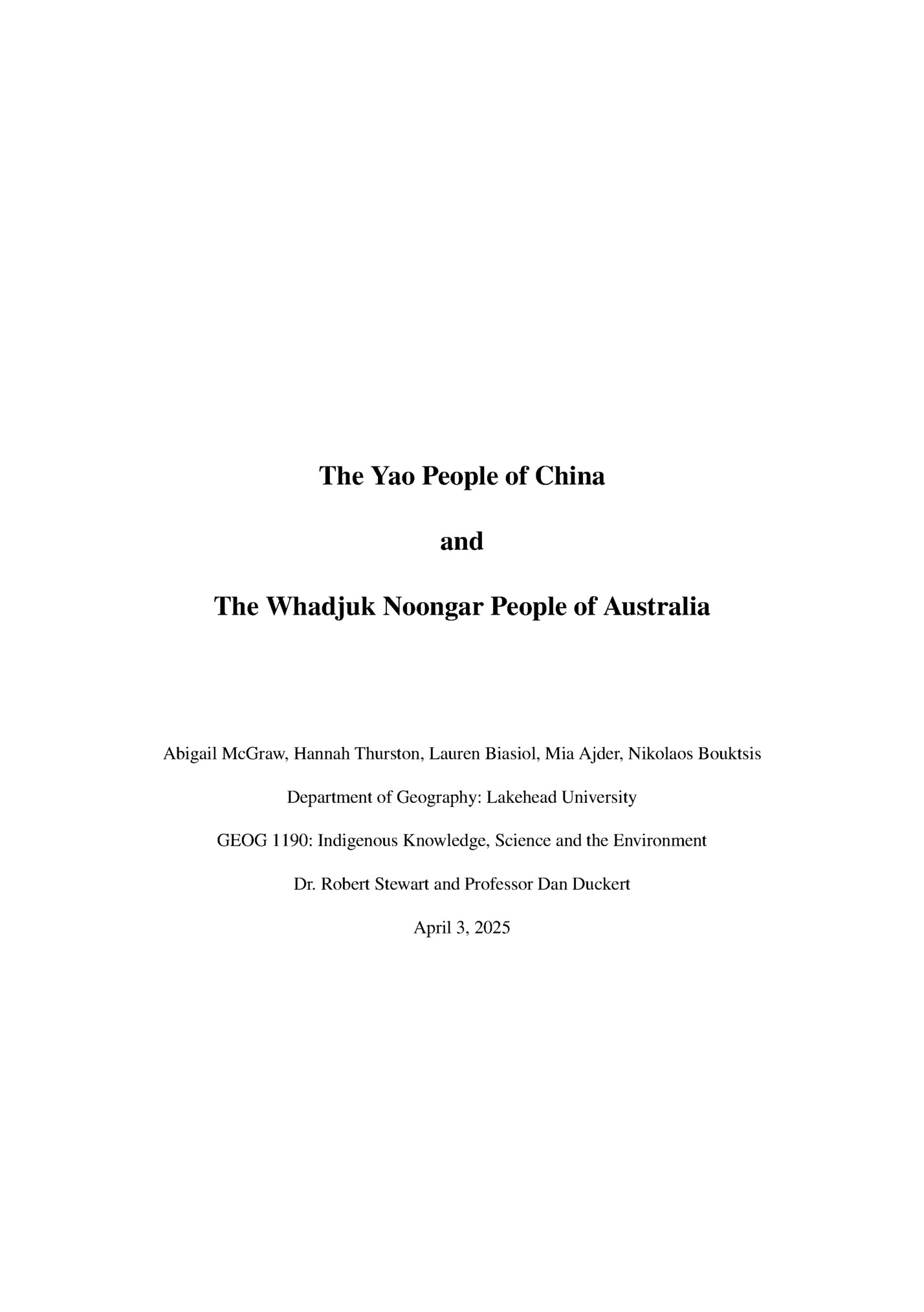
Preface Our group decided to research the Yao people of China and the Whadjuk Noongar people of Australia. When attempting to decide the format in which we wanted to present our information, we reflected on the teachings and lessons that we received from this class. If this class taught us anything, it is that through listening to the voices and stories of others, you can learn so much more than just reading a textbook. We really appreciated how much of this class felt like it was conversational, and how we absorbed lessons from just hearing our professors and guest speakers talk about their knowledge and experiences. Consequently, we thought the best way to present our information to the professors would be through a somewhat scripted conversation. Each group member was assigned an area to research concerning either the Yaos or the Noongar people. Later, we re-convened as and spoke about some of the key points and information that we had each learned. We made a loose script making sure we would touch on our most important points, but more so let our content and knowledge guide the conversation. To ensure that all of our additional information and hard work was still included within the project, we made a flipbook that acts as a companion piece to our video. It is not necessary to read the book in order to understand and learn from our conversation, however it does expand more on the topics that we did not have time to cover. We hope you enjoy.
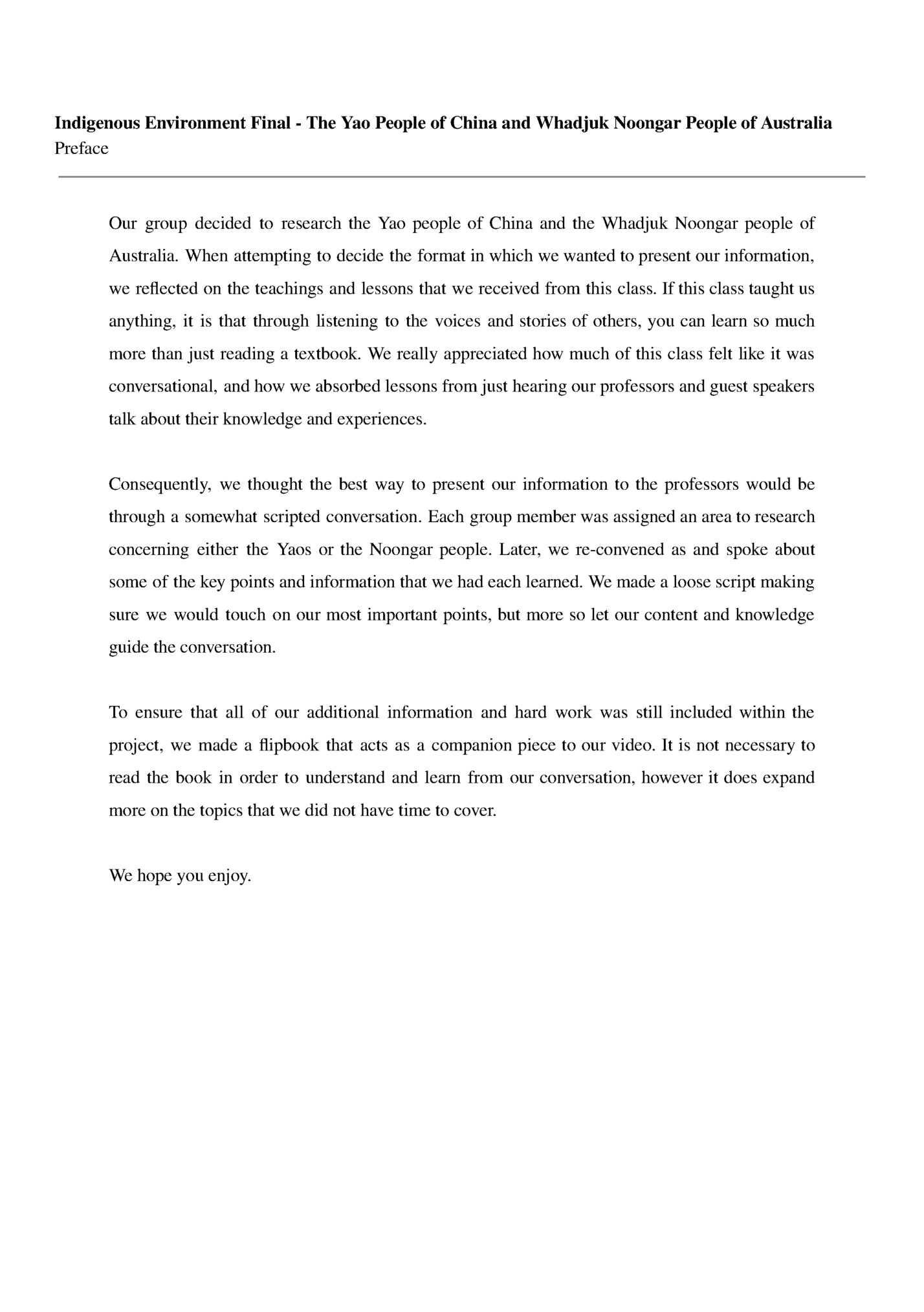
Origins and Ancestors The Yao People of China have a long, rich history. They have gone by numerous different names such as the Mian, Jinmen, Buni, Lajia and Bingduo. The origins of the Yao are thought to relate back to the Tang Dynasty of China, dating back to 618-907 A.D. Although it is believed that their origins can be traced back to two thousand years ago, predating the Han Dynasty of China in 206 BCE (Newman, 2008). Origin Story of the Yao Many Yao people believe that their origins lay within the story of Panhu, their first ancestor. Panhu also known as Panwang or Pangu is the name of a revered dragon-like dog. The story begins with Emperor Ku and his wife who was suffering from a long battle with an ear infection. She finally began to recover after a golden worm was removed from her ear and placed under a gourd. Eventually, the golden worm began to grow into a dragon-like dog and was given the name Panhu, “Hu” meaning gourd. Everyone loved and cherished Panhu for his intelligence and his cute appearance. In other parts of Emperor Ku’s land, rebellion was beginning to form under the leadership of a powerful foreign chief. The king put out a decree declaring that those who could return the head of the chief to him would be rewarded with his daughter’s hand in marriage. When all other officers and officials balked at the task, Panhu took on the quest alone. He bit the chief's head off and returned it to Emperor Ku. Panhu and the Emperor’s daughter married, and he transformed into a human after spending six days in a golden bell. The Emperor bestowed Panhu with the name of “Panwang”, “Wang” meaning king. Having no desire for wealth or rank, Panwang and his wife moved to Zhongnanshan where they lived a life of hunting, and cultivating with their children. One day while hunting, Panwang was
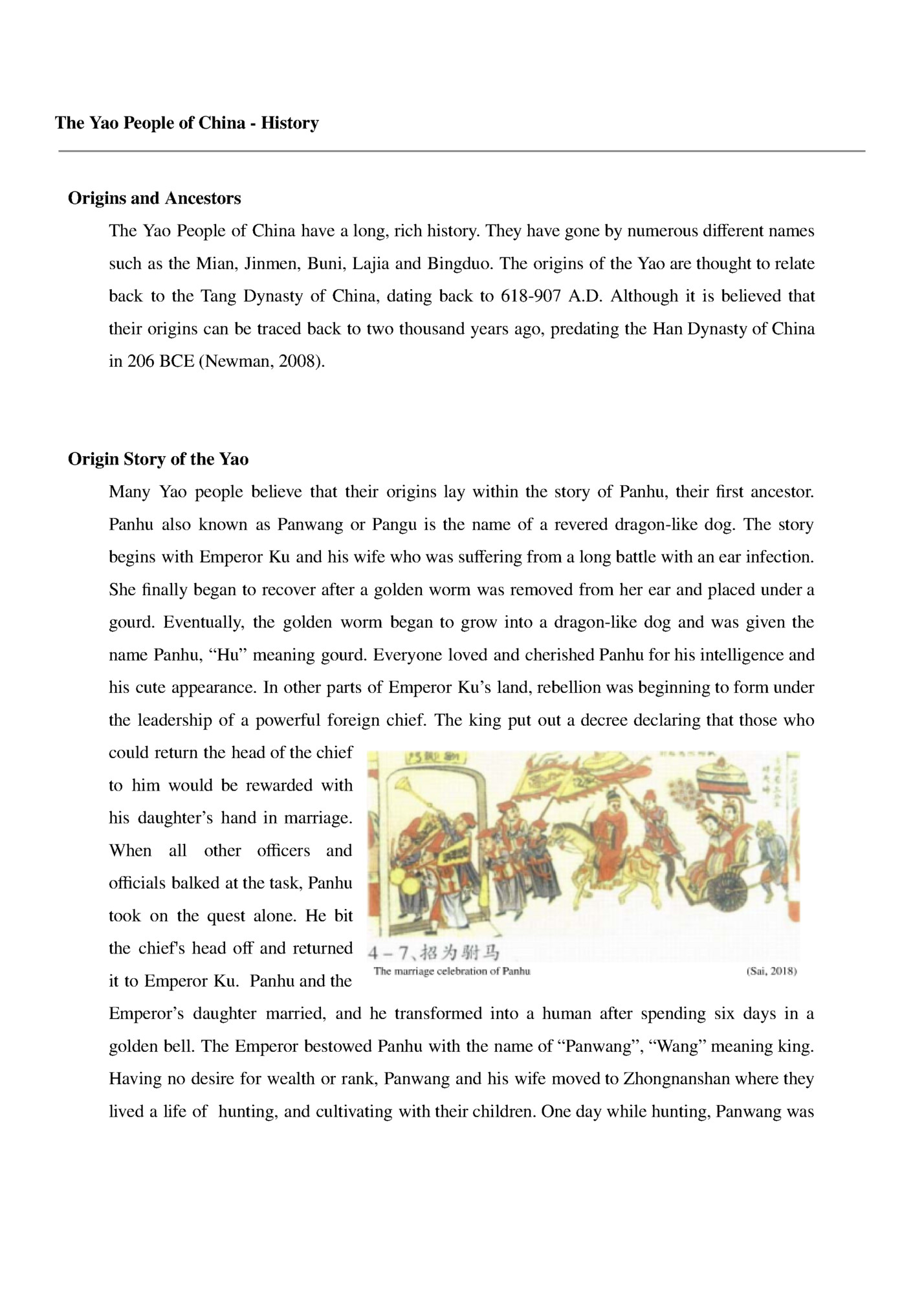
struck off a cliff by a goat and fell to his death. However, his legacy lived on. The Emperor bestowed each of his children with a surname, which are known as the earliest surnames of the Yao population today (Chinese Academy of Sciences, n.d.) Panwang is still worshipped by his descendants today, as they know he still watches over them. It is within the Yao legends that one year their villages were impacted by intense droughts, and that as a result, all the villagers with the original surnames were forced to flee their lands. While sailing to a new land, a terrible storm hit their vessels. The villagers prayed to Panwang begging him to bless them with a safe passage to land. They hit land on the 16th of October, the day that Panwang was born (Chinese Academy of Sciences, n.d.). History of the Yao People Yao were first known as the Wuling tribes and then renamed to the Moayo 2 centuries later. They were originally located in the mountainous region of Hunan, North Guangdong and North Guangxi. The increase in historical accounts about the Yao shows that they were interacting with the Han people more and more as time went on. During the Song Dynasty the Yao people of Hunan were raising cattle. Later, it spread to the Yao located in Guangxi and Guangdong. At this point, they had developed rice paddy fields and were planting crops on hillsides. From 960-1270 the Yao were given total autonomy and control over their land, so long as they pledged loyalty to the Song Dynasty. In the 1300’s however, this began to change with the Ming Dynasty. They began the practice known as “gaitu guiliu” which is translated to “replacing locals with officials.” They would send Han officials to rule and oversee Yao lands, taking away their autonomy (ChinaCulture.org, n.d.; (New World Encyclopedia, 2023).
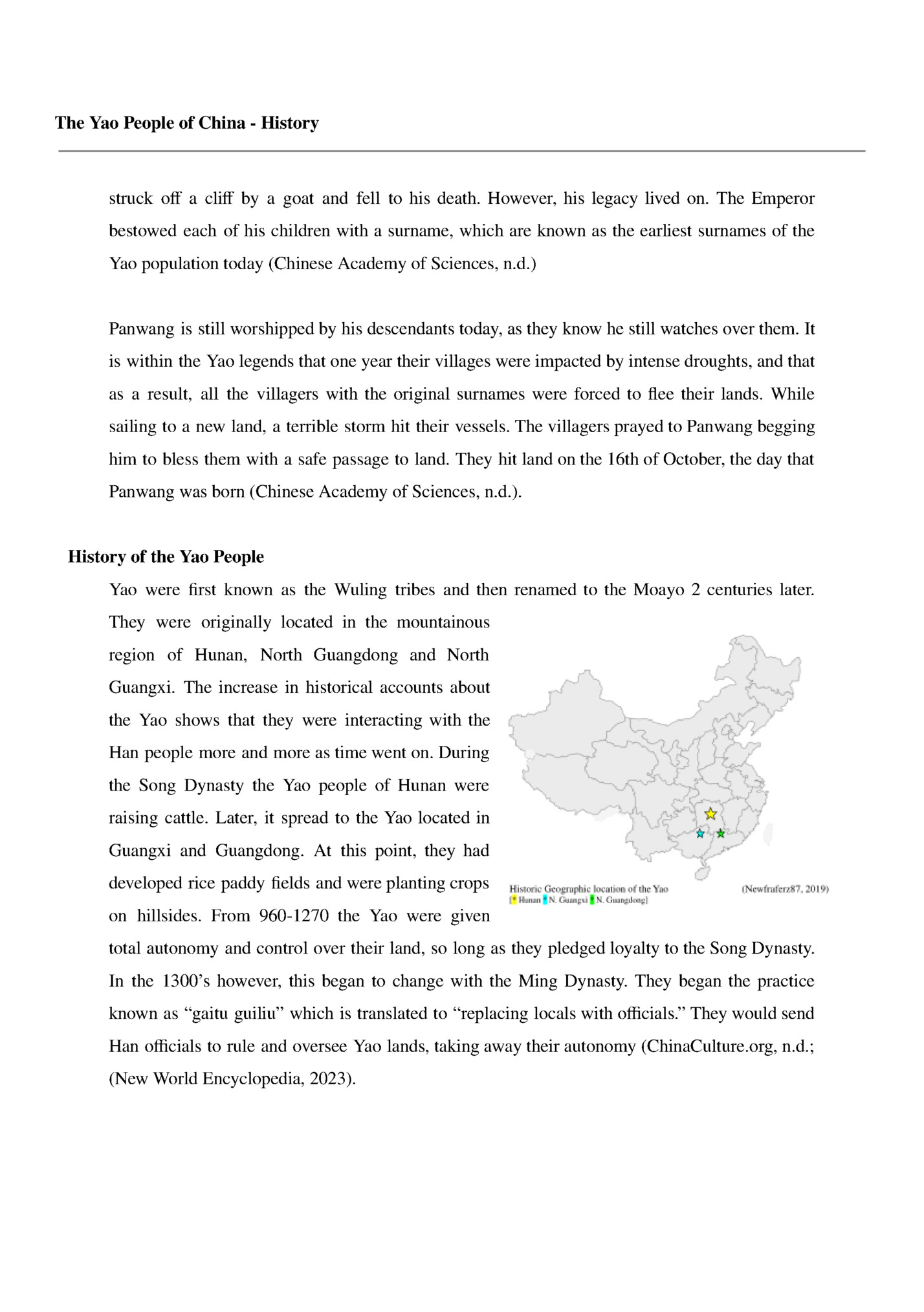
Traditional Economy of the Yao People At this point in time, the Yao economy could be divided into 3 different areas. The most common area was primarily based on agriculture and secondarily based on forestry. This economy was located in the areas where the Han’s influence was strong. The second alternative of the economy was centred around forestry and had agriculture as a secondary source. However, here, a miniscule amount of landlords from the Han and the Zhuang monopolized all the forests and hillside fields. The Yao people were forced to pay taxes to the landlords for everything that they did, whether it was ploughing, burying their dead, fishing, or other daily practices. Additionally, they were forced to plant trees in the middle of their crop fields, as a method of paying taxes. As a result, this caused the Yao to constantly be moving from area to area, as they did not want to remain in these areas long. The last economy, which consisted of the smallest percentage included the Yao people who practiced slash and burn techniques. Although most of the land in their area was owned by the Han and Zhuang landlords, they still had some farmland of their own. The land would have been passed down through the descendants of their ancestor, and owned by 20 different families (New World Encyclopedia, 2023). Historic Location of the Yao People The Yao have long since lived in the mountains predating 900 A.D. Here, they practiced slash and burn, hunting, and fishing. As a result of the policies put in place by past governments, they were constantly relocating. Moreover, the Yao were forced to migrate southwards though in order to flee the Mongols who were beginning to invade in the 13th and 14th century. The population was mostly redistributed in Guangxi however, they resettled in small amounts in other provinces
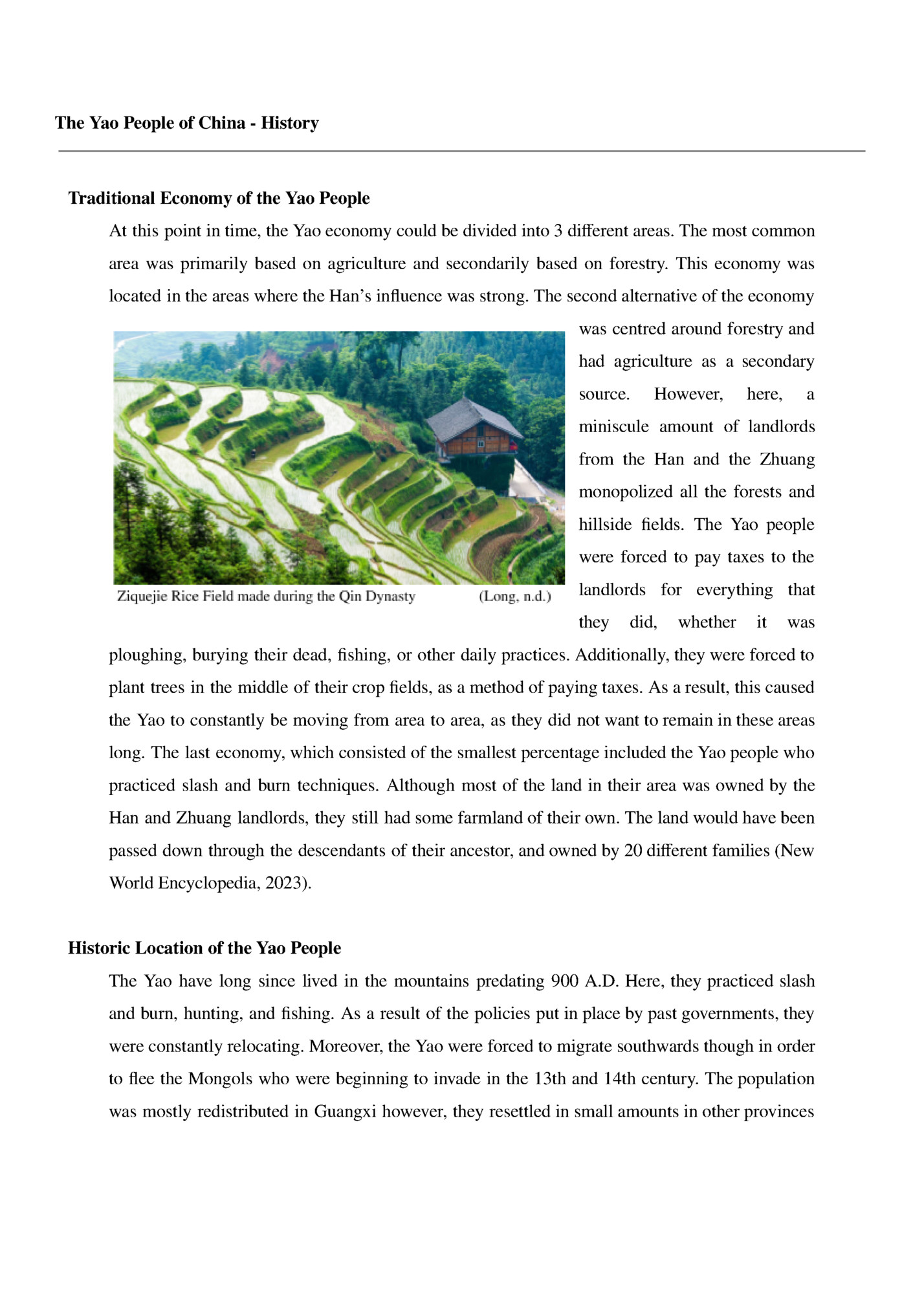
too. This established the geographic distribution of the Yao today. Although a vast majority of the Yao population still lives in China today, a number of Yao people migrated into Thailand, Cambodia and Laos as a result of the destructive Opium trade, and subsequent wars (New World Encyclopedia, 2023).
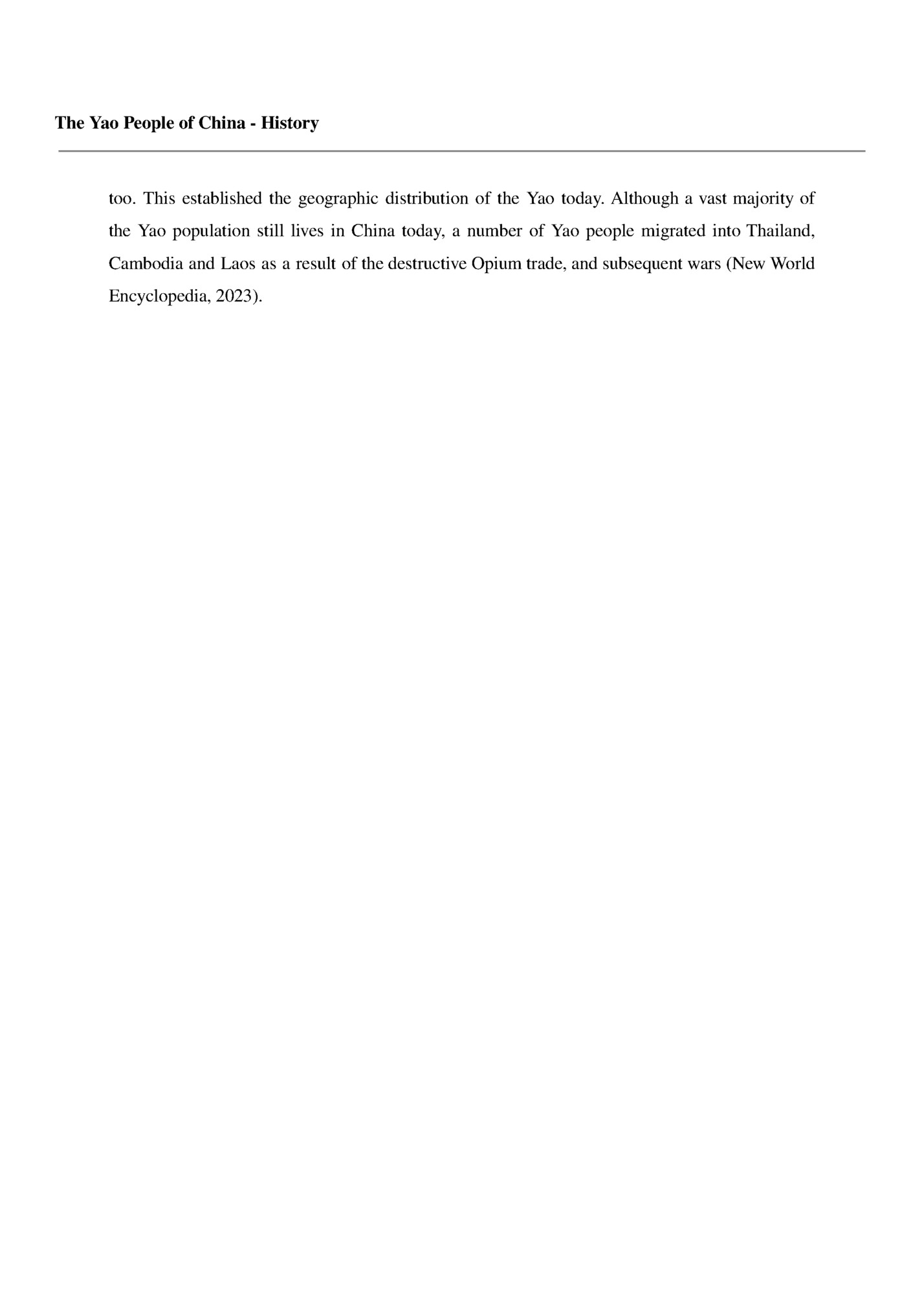
The Yao people have very unique lifestyles that differ from one community to another, however, they all share elements. Their culture is a mixture of traditional practices, and modern ones introduced from other cultures. Dialect The Yao People of China have numerous different dialects as a result of their interactions and influences from other cultures around them such as the Miao and the Zhaung. It is said that their languages differ so significantly, that Yao from one region can have difficulty understanding Yao from another area. Their language is complicated but it does belong to a shared language family known as Chinese-Tibetan. Half of the Yao - typically the older generation - speak the traditional Yao dialect. Others speak a combination of Mienic, Hmong, Miao or Dong languages, among many others (New World Encyclopedia, 2023). They do not have their own universal writing system, so they tend to use Chinese characteristics for any writing purposes. However, one very interesting aspect of the Yao culture is their written language used only for women. Nushu is a written language that was created solely for women. It originates in the Hunan province, dating back to 200-300 A.D. The script resembles Chinese script, however, rather than representing words like Chinese ideograms do, Nushu characters represent sounds like the Roman alphabet. It is thought that dialect was used as a method for women to connect with one another after they were married off and forced to move away. Additionally, it is thought that it also helped women in the “sworn sisterhood” of eternal loyalty to friends, to stay connected with one another. Nushu has lost its meaning and is beginning to die out as a language because there is more equality among men and women in Yao communities. There is not as much
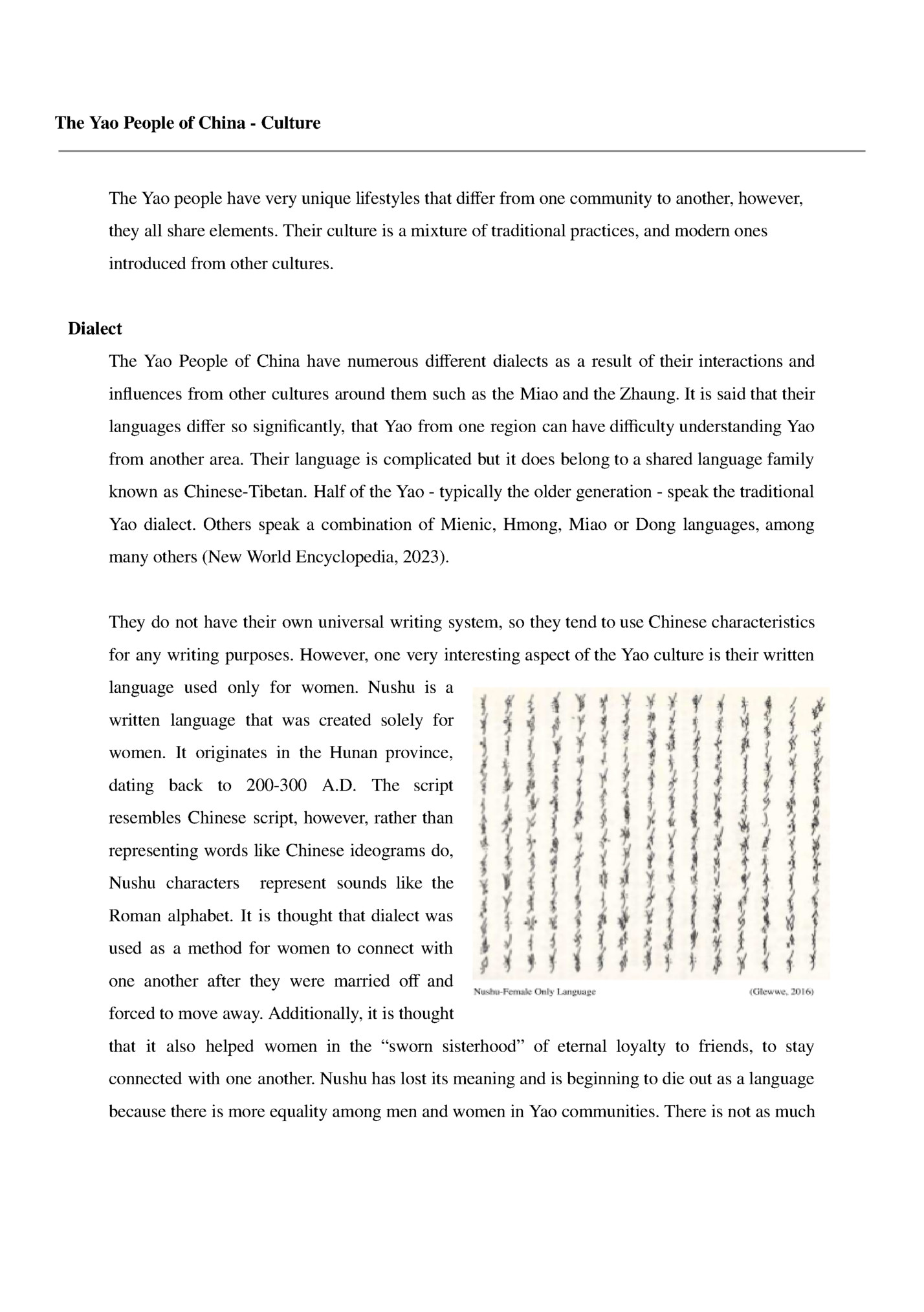
of a need for women to be secretive in their communications with one another. Few elder women can read it in the present day (Chiang, 1995). Diet and Cuisine The Yao diet is heavily representative of their heritage and is based on the agricultural resources that they have available to them, consisting primarily of vegetables and fruits. However, pork and bird meat like duck are often seen in their dishes. Home grown rice, corn, peppers, sweet potatoes, radishes, bamboo shoots, and mushrooms are also important ingredients in their cuisine. Some Yao communities often have oil tea as a part of their diet. However, others resent and shun this tea. Yao often make stir fries, rice balls, and pickle their products (Newman, 2008). Common Yao Dishes and Their Recipes Red Bean Dumplings Ingredients: - 1 cup flour - 1 Tablespoon + 1 teaspoon vegetable oil, separated - 1/4 teaspoon salt - 1 cup prepared or canned red bean paste Instructions 1. Mix the flour, tablespoon of oil, and the salt, and knead until smooth. Make one inch balls, and roll each one to about five-inch diameter. 2. Fill each piece of dough in the center with one heaping tablespoon of the bean paste, wet the edges of the dough and pleat it enclosing the bean paste. Flatten them very slightly. 3. Oil a heat-proof dish, and place the dumplings on it. Put this over rapidly boiling water, and steam for eight minutes. Then serve. (Newman, 2008)
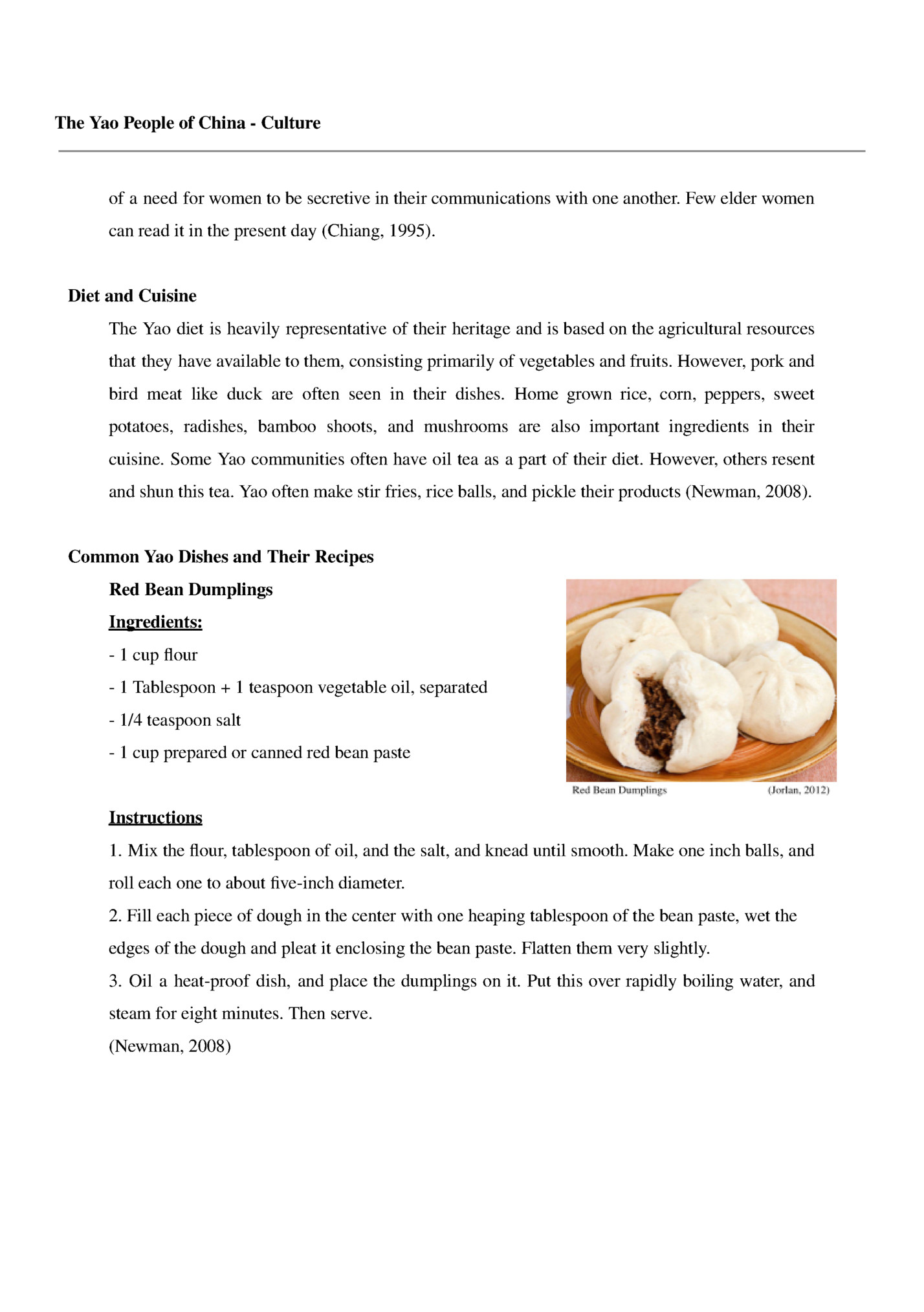
Yao Chili Mushrooms Ingredients: - 2 Tablespoons dried cloud ear mushrooms, soaked, and coarsely chopped - 2 Tablespoons dried wood ear mushrooms, soaked, and coarsely chopped - 2 Tablespoons dried Chinese black mushrooms, soaked, and coarsely chopped - 2 Tablespoons dried swordbelt mushrooms, soaked, and coarsely chopped - 2 Tablespoons dried abalone mushrooms, soaked, and coarsely chopped - 2 Tablespoons vegetable oil - 2 wild onions, cut into half-inch pieces - 1/2 carrot, peeled and diced - 2 Tablespoons corn kernels - 1 teaspoon chili paste with garlic - 1/2 teaspoon sesame oil Instructions: 1. Mix these mushrooms (or substitute others or add to this mix). 2. Heat a wok or fry pan, add the oil, and then stir-fry the mushrooms for three to five minutes before adding the onions, carrots, and kernels of corn. Continue to stir-fry another two minutes before adding the chili paste and three tablespoons of cold water and then bring this to the boil. 3. Add the sesame oil, stir once, then serve (Newman, 2008)
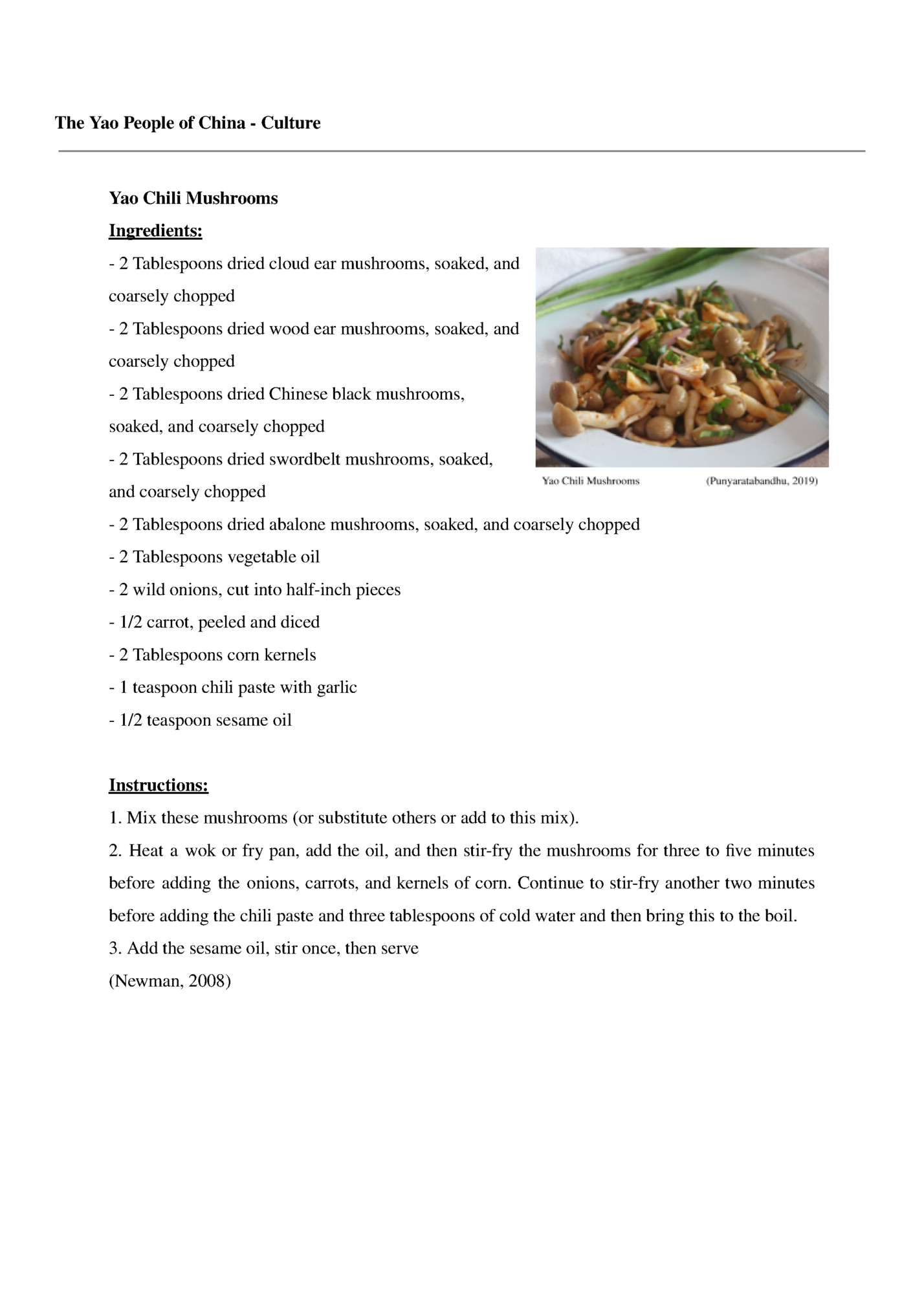
Fleepit Digital © 2021